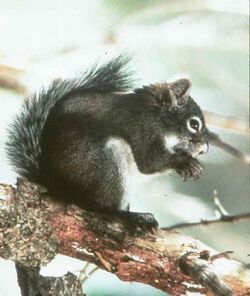Biology:Mount Graham red squirrel
| Mount Graham red squirrel | |
|---|---|

| |
| Scientific classification | |
| Domain: | Eukaryota |
| Kingdom: | Animalia |
| Phylum: | Chordata |
| Class: | Mammalia |
| Order: | Rodentia |
| Family: | Sciuridae |
| Genus: | Tamiasciurus |
| Species: | |
| Subspecies: | T. f. grahamensis
|
| Trinomial name | |
| Tamiasciurus fremonti grahamensis (J. A. Allen, 1894)
| |
| Synonyms | |
|
Tamasciurus hudsonicus grahamensis | |
The Mount Graham red squirrel (Tamiasciurus fremonti grahamensis) is an endangered subspecies of the southwestern red squirrel (Tamiasciurus fremonti)[3] native to the Pinaleño Mountains of Arizona. It is smaller than most other subspecies of red squirrel, and also does not have the white-fringed tail that is common to the species. Its diet consists mainly of mixed seeds, conifer cones and air-dried fungi. It exhibits similar behavior to other squirrels in its species.
Description
Physical
The Mount Graham red squirrel is a generally tiny squirrel weighing on average around 8 ounces (230 g) and measuring about 8 inches (20 cm) in length.[1] The subspecies also has a 6 inches (15 cm) tail.[1] Unlike most other squirrels in its species, the squirrels do not have a white-fringed tail.[1] Both females and males share similar markings and features and are typically grayish brown in color with rusty yellow or orange markings on their backside.[1] During the winter season, the squirrels ears are tufted with fur, and during the summer a black lateral line is observed on the squirrel.[1][4] The skull of the subspecies is rounded and its teeth are low-crowned.[4]
Behavior
Mount Graham red squirrels behave in a manner similar to most other subspecies of American red squirrel. They are diurnal and do not hibernate during the winter months, but instead carry out activities in the mid-day sun.[5] Mount Graham squirrels usually eat a diet of mixed seeds, conifer cones and air-dried fungi.[6]
Habitat
Historically, the Mount Graham red squirrel inhabited about 11,750 acres (47.6 km2) of spruce-fir, mixed-conifer and ecotone zone habitats that were generally at higher elevations throughout the Pinaleño Mountains.[6] Recent data shows that it occurs more frequently at the ecotone zone than the other habitats.[6] When choosing a potential nesting site, the squirrels typically pick a cool, moist area with an abundance of food sources.[6] Drought, forest fires, and insect infestation have been responsible for a decrease of the squirrel in the spruce-fir habitat.[6]
Conservation
The Mount Graham subspecies was believed to be extinct in the 1950s, but was "rediscovered" in the 1970s.[7] After its rediscovery, it was suggested for threatened or endangered species status under the Endangered Species Act in 1982.[8] On May 21, 1986, the subspecies was officially recommended to become an endangered species, and on June 3, 1987, was officially listed as endangered.[1][9] The Mount Graham International Observatory was controversial when it was built in the squirrel's habitat; the observatory has been required to monitor the community near the observatory to determine if its construction is having any negative effects on the population.[7] Habitat loss is also occurring at high levels for a variety of natural and anthropogenic reasons.[7] In 1988, the U.S. Fish and Wildlife Service designated most of this area as a refuge, and access to the area is granted only with a special permit.[7] A lightning strike on June 7, 2017, started a wildfire that could have led to the extinction of this subspecies.[10]
In September 2019, the U.S. Fish and Wildlife Service agreed to consider if the squirrel needed further protection. They were petitioned under a procedure of the Endangered Species Act by a group that contends it is necessary to remove the observatory and other private structures.[11]
References
- ↑ 1.0 1.1 1.2 1.3 1.4 1.5 1.6 "Mount Graham Red squirrel (Tamiasciurus hudsonicus grahamensis)". U.S. Fish and Wildlife Service. http://ecos.fws.gov/speciesProfile/profile/speciesProfile.action?spcode=A09O. Retrieved 10 April 2010.
- ↑ "NatureServe Explorer 2.0". https://explorer.natureserve.org/Taxon/ELEMENT_GLOBAL.2.101915/Tamiasciurus_fremonti_grahamensis.
- ↑ "Explore the Database". https://www.mammaldiversity.org/explore.html#species-id=1001705.
- ↑ 4.0 4.1 Fitzpatrick, Lesley; Genice Froehlich (May 3, 1993). "Mount Graham red squirrel". U.S. Fish and Wildlife Service Albuquerque, New Mexico. http://www.fws.gov/southwest/es/Arizona/Documents/RecoveryPlans/MtGrahamRedSquirrel.pdf. Retrieved 10 April 2010.
- ↑ "The Natural History of the Mount Graham Red Squirrel". The University of Arizona. http://www.ag.arizona.edu/research/redsquirrel/mgrs-nathistory.html. Retrieved 13 September 2012.
- ↑ 6.0 6.1 6.2 6.3 6.4 "Mount Graham Red Squirrel (Tamiasciurus hudsonicus grahamensis) 5-Year Review: Summary and Evaluation". U.S. Fish and Wildlife Service Arizona Ecological Services Field Office Phoenix, Arizona. January 2008. http://ecos.fws.gov/docs/five_year_review/doc1617.pdf. Retrieved 10 April 2010.
- ↑ 7.0 7.1 7.2 7.3 "The Mt. Graham Red Squirrel Research Program Project History". The University of Arizona. http://www.ag.arizona.edu/research/redsquirrel/mgrs-projhistory.html. Retrieved 13 September 2012.
- ↑ "Endangered and Threatened Wildlife and Plants; Review of Vertebrate Wildlife for Listing as Endangered or Threatened Species". Fish and Wildlife Service, Interior.. December 30, 1982. http://ecos.fws.gov/docs/federal_register/fr650.pdf. Retrieved 10 April 2010.
- ↑ "50 CFR Part 17". Fish and Wildlife Service, Interior. May 21, 1986. http://ecos.fws.gov/docs/federal_register/fr1142.pdf. Retrieved April 10, 2010.
- ↑ Albeck-Ripka, Livia (October 25, 2017). "For an Endangered Animal, a Fire or Hurricane Can Mean the End". New York Times. https://www.nytimes.com/2017/10/25/climate/fires-hurricanes-endangered-animals.html.
- ↑ "US officials to consider protections for endangered Arizona squirrel". KTAR News. September 5, 2019. Archived from the original on 2019-09-10. https://web.archive.org/web/20190910194909/https://ktar.com/story/2725706/us-officials-to-consider-protections-for-endangered-arizona-squirrel/. Retrieved September 8, 2019.
External links
- USFWS Page
- Mount Graham Red Squirrel Research Program at School of Natural Resources and the Environment at University of Arizona
Wikidata ☰ Q6920967 entry
 |



